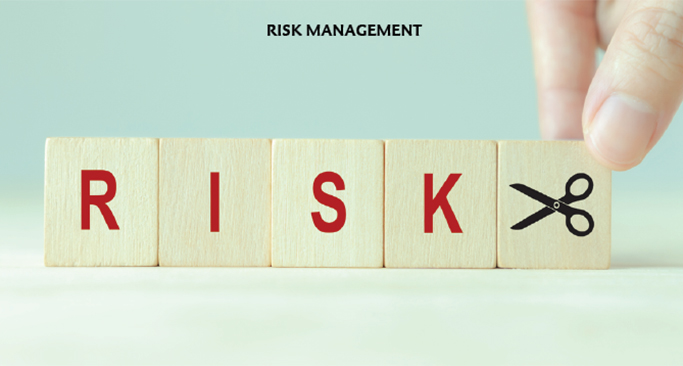SPOTLIGHT ON MANAGING RISK
How can agents and brokers help
bring clarity to their clients?
By Lori Widmer
Fraud, supply chain resilience, ESG, cyber threats and business interruption—these are just some of the issues that face organizations today. In a world rife with risks, how are agents and brokers to bring clarity to their clients when it comes to the most pressing risks?
We talked with three top executives from the insurance industry for a snapshot into the main exposures companies face and the ways agents and brokers can help their customers address those risks.
Facing fraud
Despite a significant investment in IT security measures, fraud across the financial services and insurance sectors is rampant. A Veriff 2023 Identity Fraud Report reveals that the industry saw a 9.73% growth in fraudulent trans-actions in 2022, with 51% of those being identity fraud.
Sandra Krasny, head of insurance for INFORM Risk & Fraud Division, is not surprised. “Across the financial services sector, including insurance, there has been a steady increase in the number of frauds being committed, with criminals continuously finding new ways to bypass new fraud measures,” she says.
As she points out, fraud is costly for U.S. businesses and consumers. She points to figures released by the Coalition Against Insurance Fraud, which places insurance fraud costs at a staggering $308 billion annually.

Across the financial services sector, including insurance, there has been a steady increase in the number of frauds being committed, with criminals continuously finding new ways to bypass new fraud measures.”
—Sandra Krasny
Head of Insurance
INFORM Risk & Fraud Division
Krasny says that the largest risk affecting the industry is external attacks. These, she says, cause the highest losses. Ransomware, phishing, denial-of-service attacks and email scams are common methods used by hackers. With global cyber attacks increasing by 38% in 2022 over 2021, Krasny says the proliferation of online and virtual work tools and operations will only increase that risk. “With many businesses now moving to the cloud, there are also increased risks, especially when businesses rely on a small number of cloud providers which can impose additional risks.”
Expect to see pricier repercussions, she adds. Even so, Krasny thinks that in itself could be where the opportunity for change will come. “We expect that increasing regulations and penalties for failure to take all necessary measures to prevent fraud and the compromise of sensitive personal data will drive more prudent adoption of enterprise risk and financial crime management solutions.”
It’s already happening, she says. “Today, we are seeing more insurance companies investing in better technologies to improve their fraud detection with advanced technologies like artificial intelligence (AI), machine learning, fuzzy logic and data-driven methods playing a major role.”
Still, insurance has not been quick to get behind the change. “The industry has been slower than others to implement new technologies to combat fraud,” Krasny says. “Companies are, however, recognizing the need to adopt a fraud risk management culture wherein the risk management function is not confined to just the risk management and internal audit units but, instead, all employees are being trained and considered to be part of the risk prevention team.”
Krasny says that new fraud detection systems, technology investments and the like have helped, though agents and brokers can expect to see increased premiums as a result. For carriers and brokers to get ahead of the risks, though, such costs must be incurred. “It’s import-ant that carriers and brokers alike adopt enterprise risk and financial management solutions that integrate both data-driven and knowledge-driven methods of AI which can be found in a hybrid AI technology.”
Krasny also recommends that along with technology and “intuitive rule management, predictive analytics and fraud case management, insurers and brokers need to take other measures.” Employees, she said, need training and education in how to detect fraud as they are often the targets as well as the first line of defense in any phishing attempt.
That’s where agents and brokers can serve in an advisory role with their clients. Agents and brokers “should take the time to become aware of the financial crimes affecting their industry and staying abreast of the latest fraud trends. Most important, they need to adopt best practices in terms of internal policies and procedure, employee education and training, and advanced enterprise risk and fraud management technologies that automate fraud detection and risk monitoring with real-time response.”
Emerging issues and trends
While the pandemic drove more virtual operations, adding to the cyber risk exposure, emergence from the pandemic has put pressure on organizations in another way, says Lambros Lambrou, CEO of Commercial Risk Solutions at Aon. Inflation and geopolitical risks are two key challenges—ones that will continue. “In 2023, we’re seeing four key trends emerging, from the building of supply chain resilience and continued attention on ESG and climate, to in-creased volatility due to inflation and a resulting impact on pricing as well as ongoing cyber threats,” he says.
A recent KPMG report states that supply chain disruptions are expected to continue and deepen as geopolitical conflict, climate issues and inflation bear down. The good news is that, according to Lambrou, such pressures have not made a huge impact on the insurance market. “We’ve seen modest price increases driven by inflation and anticipation of treaty renewals. It is too early to know what impact higher inflation will have on longer-tail lines as claim factors, such as medical and litigation costs, take time to unfold. As costs rise, insurers may need to rely more on operational efficiency and in-vestment earnings to help minimize any shortfall between premium revenue and claims payouts.”

“We’ve seen modest price increases driven by inflation and anticipation of treaty renewals. It is too early to know what impact higher inflation will have on longer-tail lines as claim factors, such as medical and litigation costs, take time to unfold.”
—Lambros Lambrou
CEO, Commercial Risk Solutions
Aon
Fortunately, other factors have help-ed contribute to a more stable insurance market. “Improved insurer performance, focus on retention and growth, and increased capacity had a dampening effect. Conditions were moderate; sectors and risks deemed likely to create volatility for insurers experienced a more conservative and challenging pricing environment, with natural catastrophe property experiencing the most significant increases.”
As geopolitical conflicts and their impact continue to be felt along the supply chain, economic improvement could be thwarted in the short term. And as the pandemic continues, pressure on companies to keep their hybrid work options could bring about more cyber exposure. Still, Lambrou believes innovation in other areas could drive a more stable insurance outlook. “We expect to see leaps in innovation aiming to tackle the ever-evolving cyber security landscape,” he says. “The prominence of long-term hybrid working, rise in ransomware, and occurrence of wide-spread data breaches will serve to drive a material increase in cyber security in-vestment as cyber priorities make it to the top of the agenda for most companies around the globe. In the 2021 Global Risk Management Survey, cyber was named the current and future top risk.”
Not surprising given the prominence of remote work. Still, Lambrou believes that agents and brokers who keep abreast of the totality of a client’s risk portfolio can become a trusted partner. He recommends “working with insurers throughout the year to build strategic relationships and bring them along on your journey so there are no surprises at renewal. It’s important to start
renewal planning early and have meetings to preview appetite and pricing, analyzing data to evaluate market alternatives and explore viability.”
The smart agent or broker will bring transparency and that sense of collaboration to the relationship, Lambrou adds. “Being forthright in providing comprehensive underwriting information—especially related to risk control and mitigation practices and actions taken from past recommendations—is also helpful, alongside discussion agendas that are focused on differentiated strengths and key concerns. Highlight lessons learned from past claims and actions being taken to build resilience.”
While little can be done to mitigate inflation or geopolitical risks, Lambrou says that focusing attention on how those issues impact the client “over the medium to long term” can help bring clarity to their risk management strategies. He suggests that agents and brokers follow cyber, supply chain, food security, climate transition, energy security, ESG and public sentiment exposures. “Since these risk areas are evolving and highly interconnected, it is more vital than ever that businesses commit to building resilience, including maintaining a well-informed, broad and strategic approach to risk.”
And know that those risks are always evolving and changing. “As market dynamics shift, so do client needs—which was true for 2022,” Lambrou says. “We found there is a greater need to innovate new and existing products because of increased demand, to invest in data, analytics and risk modelling to identify alternative and traditional risk transfer solutions, and to have flexible cross-industry facilities that have proved invaluable in transferring risk across a range of exposures.”
Transformation and transparency
Fortunately, brokers and insureds are already tuning in to the potential threats. “We are seeing more awareness with insureds and brokers in terms of understanding the exposure impacts of cyber and business interruption,” says Thomas K. Varney, regional manager of Risk Consulting for Allianz Global Corporate & Specialty (AGCS) North America.
Insureds, he says, are looking for ways to create more agile work models. “Insureds today are looking at potentially transforming business models and seeing how these can be more flexible and adaptable to potential changes in terms of competition, political or macro-economic exposures.”
He’s also seeing an increased investment and focus on renewable energy solutions such as “lithium-ion battery usage and the impact this may have on certain industries.”
But by far the most significant risk exposure Varney sees is one that is highlighted in the Allianz Risk Barometer 2023—“the shortage of a skilled work-force,” he says. “This is an area that needs more attention. Globally, in this year’s Risk Barometer, this exposure came in eighth, but in the U.S. it ranks fourth and in Canada it comes in second.”
In fact, Varney points out that the exposures that all companies face require a skilled workforce “to address the issues at hand—a team to provide ongoing sup-port and continued research to mitigate potential threats and trends.”
Yet the persistence of the labor crunch gripping all sectors is making it difficult for any industry to effectively mitigate its exposures. Until the labor shortage is addressed, Varney says, expect exposures to take hold more firmly.
Not that the insurance industry isn’t trying to put together a more action-able response, which is happening among all stakeholders without prejudice. Insurance companies “continue to work proactively on emerging risks and trends as there is a continuous exchange of information between carriers, brokers and clients,” says Varney. There are also industry and client-specific expo-sure concerns that are addressed as part of the policy lifecycle process. Ongoing communication and collaboration are key to meeting the ever-changing needs of businesses today. “
Those collaboration efforts are netting some results. Insureds, Varney says, “are utilizing business continuity plans to test an organization’s ability to handle potential business risks they may face. This approach uncovers potential mitigation shortfalls in a safe or test environment and enables businesses to make required changes before problems materialize.”
Another key strategy: apply transparency. “Many companies are also looking to improve their supply chain transparency,” he adds.
Likewise, Varney sees organizations putting effort and investment behind efforts to mine quality exposure data. “They are increasingly seeing the value of such information and its benefit to overall operations,” he says.
In fact, Varney believes the one-two punch to risk mitigation comes when insurers and brokers bring their own IT to the table. “Carriers and brokers are also increasing their application of innovative mechanisms to help address potential exposures.”
He says a prime example is how technology is used to better model natural disasters, “mainly hurricanes. Continuous improvement of the instruments tracking these types of events, coupled with the improved science and technology behind the understanding of climate change and how it may impact the severity of events is the backbone of many risk-management programs.”
Each step in a company’s operations can be improved with technology that brings a higher level of transparency, Varney says. “Logistics and the under-standing of supply chains is also an area where technology is improving overall transparency. Additionally, and as stated earlier, the investment by many companies in data generation and how it can be used to help reduce or eliminate possible risk is also being considered and applied across numerous industries.”
So where should agents and brokers be focusing their attention when it comes to increased risks? The focus, says Varney, should be on how to best “de-risk” client business operations. “Insurance is only one aspect of this analysis process; reviewing business models for agility amidst marketplace changes is key,” he says. “Developing, testing and revamping business continuity plans to ensure clients are addressing all potential exposures is also important.”
He reminds agents and brokers that each business comes with its own unique issues. “As no two businesses are alike, it is imperative to identify and address specific concerns. This is why transparent discussions between clients, brokers and carriers need to take place in order to identify all issues and agree on how insurance can best be used to secure the situation.”
For more information:
Allianz Global Corporate & Specialty North America
www.agcs.allianz.com
Aon
www.aon.com
INFORM
www.inform-software.com
The author
Lori Widmer is a Philadelphia-based writer and editor who specializes in insurance and risk management.





